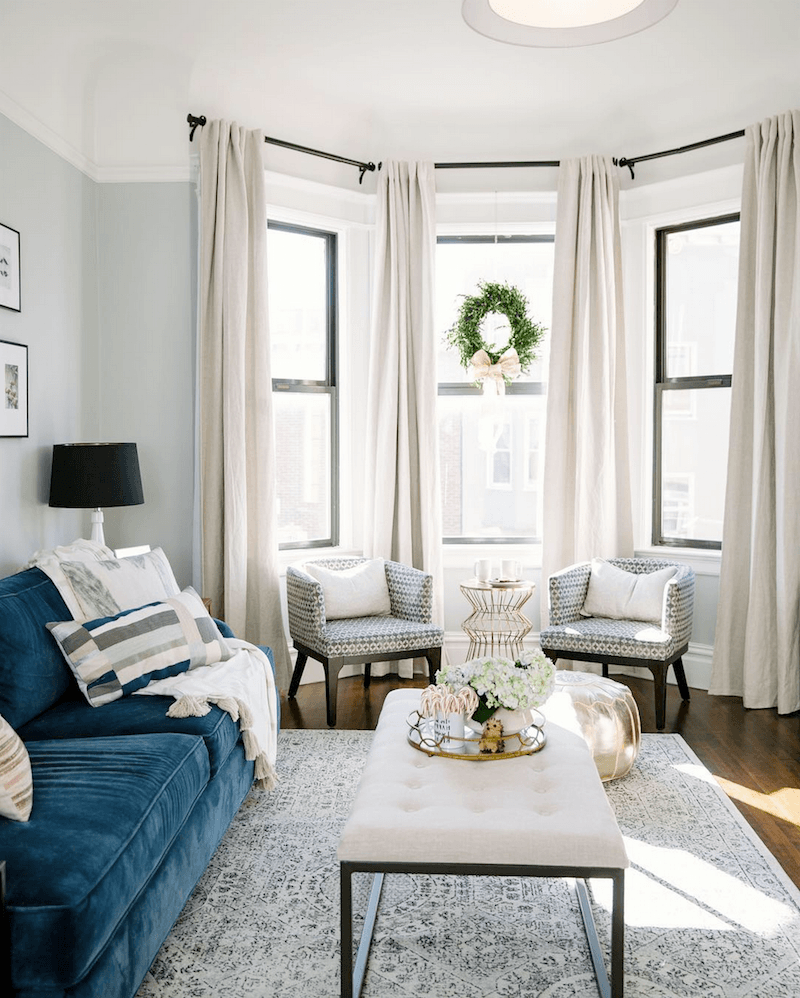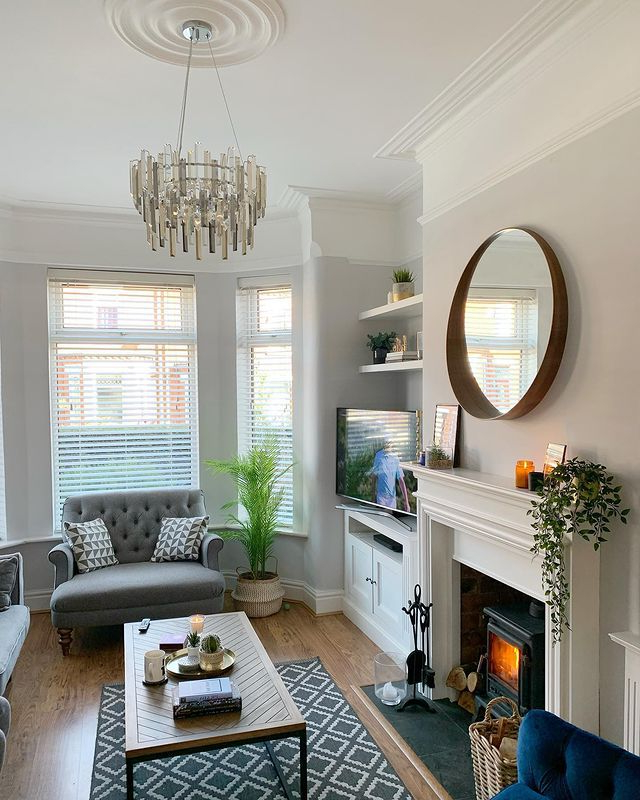Imagine stepping into a living space where the gentle glow of morning sun dances across polished floors, where the view outside becomes part of your interior story, and where every corner feels like a conversation starter. Bay windows have transformed from simple architectural features into powerful design statements that reshape how we experience our living spaces. These elegant protruding windows don’t just let in light – they create entire zones within your home that feel both intimate and expansive.
In today’s world of open-concept living and biophilic design, bay window living rooms have emerged as some of the most coveted spaces in modern homes. These architectural gems offer more than just spectacular views and abundant natural light – they provide unique opportunities to create distinct areas within a single room. Whether you’re planning a complete renovation or simply looking to enhance your current living space, understanding how to thoughtfully design around a bay window can completely transform your home’s energy and aesthetic. The key lies in balancing the window’s natural beauty with functional furniture placement, comfortable seating arrangements, and thoughtful styling that makes the most of every square foot.
Understanding Bay Window Architecture
Bay windows aren’t just decorative elements – they’re structural features that fundamentally change how a room functions. These three-sided windows extend outward from the main wall, creating a triangular or polygonal space that offers several advantages. The most obvious benefit is the flood of natural light they bring in, which can make even the smallest rooms feel airy and bright. But beyond lighting, bay windows create distinct zones within a larger space. You might find yourself naturally drawn to one side for reading, another for entertaining, or perhaps a third area perfect for displaying collections or artwork. The geometry of these windows also offers interesting challenges and opportunities for creative furniture arrangement. Unlike standard rectangular rooms, bay windows require you to think three-dimensionally about your layout, considering not just floor space but also the visual space created by the window’s projection.
The Most Popular Bay Window Layout Styles
Modern homeowners gravitate toward several classic bay window configurations when designing their living spaces. The traditional three-window bay setup remains incredibly popular, offering balanced proportions that work well in most room sizes. This style typically features two side windows flanking a central, often larger, window. Another favorite is the four-window bay, which provides even more light and creates additional seating areas. For those with limited space, the single-window bay or bow window can offer all the benefits of a bay window in a more compact form. Each style presents different possibilities for furniture placement and functional zones. The key is matching your chosen layout to your room dimensions and lifestyle needs. Consider how much traffic will move through the space, where you want to place seating, and whether you’ll be using the window area for reading, dining, or simply enjoying the view.
Creating Functional Zones Within Your Bay Window Space
One of the greatest advantages of bay window living rooms is the ability to create multiple functional areas within one space. Think of the window area as a canvas where you can paint different experiences. The window seat itself can become a cozy reading nook, perfect for curling up with a good book on a quiet afternoon. The triangular space formed by the window’s projection can serve as a dedicated conversation area, especially if you position comfortable seating to face each other. You might also consider using the window alcove for displaying plants, books, or decorative objects that complement your overall design scheme. The key to successful zoning is ensuring each area feels distinct while maintaining visual connection to the whole room. This can be achieved through strategic furniture placement, varying ceiling heights, or even subtle changes in flooring materials.
Furniture Placement Strategies for Maximum Impact
Getting furniture right in a bay window room requires a delicate balance between functionality and aesthetics. Start by identifying the focal points – usually the window itself and the views beyond it. Position seating so that people can enjoy both the natural light streaming in and the outdoor scenery. A common mistake is placing large furniture pieces directly in front of the window, which blocks the view and eliminates the primary benefit of the bay window. Instead, consider placing smaller, more flexible pieces that can be moved around as needed. The window seat itself should be comfortable enough for extended periods of sitting but not so bulky that it overwhelms the space. Coffee tables and side tables can be positioned strategically to create conversation areas without blocking the window’s natural light. Remember that the bay window’s unique shape means that traditional rectangular furniture arrangements won’t always work perfectly. Sometimes, the most creative solutions come from thinking outside the box and embracing the three-dimensional nature of the space.
Lighting Considerations for Every Time of Day
Natural light is the star attraction in any bay window room, but thoughtful artificial lighting ensures your space remains inviting and functional throughout the day and night. During daylight hours, the abundance of natural light means you’ll want to choose window treatments that can control both light and privacy. Sheer curtains or blinds allow the beautiful natural light to stream in while providing a soft filter for privacy when needed. As evening approaches, layering artificial lighting becomes crucial. Table lamps, floor lamps, and wall sconces can create the warm ambiance that makes the space feel cozy and welcoming. Consider dimmer switches to adjust the lighting levels based on your activities – bright light for reading and working, softer light for relaxing and entertaining. The bay window’s unique geometry also means that light can bounce differently off the walls and surfaces, creating interesting shadows and highlights that add depth and character to your room.
Styling Tips That Enhance Your Bay Window Design
The way you style your bay window space can make or break the overall look and feel of your room. Start with the basics: choose window treatments that complement your existing decor rather than compete with it. If you have a minimalist design scheme, clean lines and neutral colors will work best. For more eclectic styles, you might experiment with patterned fabrics or bold colors that tie into your overall palette. Plants are particularly effective in bay window spaces because they take advantage of the abundant natural light while adding life and color to the area. Consider different heights and types of plants to create visual interest. Textiles play a crucial role too – throw pillows, blankets, and rugs can add warmth and comfort to the window seating area. Don’t forget about accessories like books, candles, or small sculptures that can personalize the space and make it feel uniquely yours. The key is to avoid overcrowding – let each element breathe and contribute to the overall harmony of the room.
Practical Considerations for Everyday Living
While the aesthetic appeal of bay window living rooms is undeniable, practical considerations shouldn’t be overlooked. The window seat area needs to be comfortable enough for regular use but not so deep that it becomes difficult to clean. Consider materials that are easy to maintain and can handle daily wear and tear. If you have children or pets, you’ll want to think about safety features like rounded corners and secure window treatments. Storage solutions can be tricky in bay window spaces, but clever options like built-in shelving or storage boxes tucked under the window seat can help keep the area organized. The window’s exposure to weather also matters – if it faces west, you might need to consider heat buildup during afternoon hours. Planning for seasonal changes is important too, as the angle of sunlight shifts throughout the year. Having a plan for how you’ll adapt the space for different seasons and times of day ensures your bay window room remains functional and beautiful year-round.
Budget-Friendly Bay Window Transformations
You don’t need a massive renovation budget to transform your bay window space into something special. Simple changes can make a dramatic difference in how the room feels and functions. Start with affordable updates like new window treatments, fresh paint colors, or updated lighting fixtures. Adding a few carefully selected pieces of furniture can completely change the dynamics of the space. Even small touches like new throw pillows, a stylish rug, or some well-placed plants can refresh the entire atmosphere. Consider repurposing items you already own – perhaps a vintage chair that fits perfectly in the window alcove, or a collection of books that can be displayed on the window ledge. DIY projects like painting the window frame or creating custom window seat cushions can add personal touches without breaking the bank. The key is focusing on quality over quantity and choosing pieces that will stand the test of time rather than following fleeting trends.
Modern Trends in Bay Window Design
Contemporary bay window design continues to evolve with changing lifestyles and design preferences. One emerging trend is the integration of technology into these spaces, with hidden speakers, smart lighting systems, and even built-in charging stations becoming more common. Sustainability is also playing a bigger role, with homeowners choosing eco-friendly materials and energy-efficient window treatments. The rise of multifunctional furniture has made it easier to maximize bay window spaces, with pieces that can serve multiple purposes – like ottomans with storage or coffee tables that double as work surfaces. Minimalist approaches are gaining popularity, emphasizing clean lines and uncluttered spaces that let the natural beauty of the window and surrounding views take center stage. Color palettes are trending toward earth tones and neutral shades that create calming atmospheres, though bolder accent colors are still used strategically to add visual interest and personality.
Common Mistakes to Avoid When Designing Bay Window Spaces
Many homeowners encounter pitfalls when trying to design their bay window rooms effectively. One frequent error is ignoring the window’s practical function – it’s easy to focus purely on aesthetics and forget about usability. Make sure there’s adequate clearance around the window for opening and closing operations. Another common mistake is overwhelming the space with too many competing elements. Remember that less can often be more, especially in smaller bay window areas. Choosing furniture that’s too large for the space can make everything feel cramped and uncomfortable. Don’t overlook the importance of proper window treatment selection – the wrong choice can either block too much light or create glare issues. Finally, many people forget to consider the room’s overall flow and how the bay window area relates to adjacent spaces. The window should enhance rather than disrupt the natural movement through the home.
Bay window living rooms represent more than just architectural features – they’re opportunities to create spaces that truly reflect your lifestyle and personality. The key to success lies in understanding how to work with the unique characteristics of these spaces rather than against them. Whether you’re starting from scratch or looking to refresh an existing bay window area, remember that thoughtful planning, strategic furniture placement, and attention to both form and function will create a space that’s both beautiful and practical. The beauty of bay window design is that it adapts to your needs and evolves with your lifestyle. With careful consideration of light, space, and style, these remarkable architectural elements can transform your home into a haven that celebrates both indoor comfort and outdoor beauty. The possibilities are as endless as your imagination, and the rewards are well worth the effort of thoughtful design.















